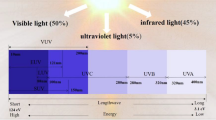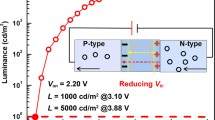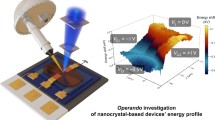Abstract
The purpose of this paper is to investigate the effect of the thickness of the wetting layer (WL) and the number of quantum dots (QDs) on the performance of 1.3 µm QD vertical-cavity surface-emitting lasers (QD-VCSELs) using self-consistent model based on rate equations and thermal conduction equations. QD-VCSELs' output power and modulation bandwidth rolled-over due to self-heating. Results demonstrate that at the same bias current, the maximum achievable 3-dB modulation bandwidth and output power are not achieved, and the point of maximum 3-dB modulation bandwidth occurred at lower currents. In addition, the larger wetting layer thickness and the greater number of QD layers modify the self-heating and enhance the efficiency and output characteristics of the laser where the rolled-over of the laser happens at higher bias currents. Furthermore, since wetting-layer thickness and the number of QD layers increase, the self-heating phenomenon is modified and the efficiency and output characteristics of the QD-VCSELs are improved by the output power rollover at higher bias currents.












Similar content being viewed by others
Availability of data and material
Not applicable.
Code availability
Not applicable.
References
C. Tong, X. Dawei, S.F. Yoon, Y. Ding, W.J. Fan, Temperature characteristics of 1.3-µm p-doped InAs–GaAs quantum-dot vertical-cavity surface-emitting lasers. IEEE J. Sel. Top. Quantum Electron. 15(3), 743–748 (2009)
C.W. Wilmsen, H. Temkin, L.A. Coldren, Vertical-cavity surface-emitting lasers: design, fabrication, characterization, and applications, vol. 24 (Cambridge University Press, 2001)
K. Mukai, Y. Nakata, K. Otsubo, M. Sugawara, N. Yokoyama, H. Ishikawa, 1.3-µm CW lasing characteristics of self-assembled InGaAs-GaAs quantum dots. IEEE J. Quantum Electron. 36(4), 472–478 (2000)
R.P. Sarzala, Modeling of the threshold operation of 1.3-µm GaAs-based oxide-confined (InGa) As-GaAs quantum-dot vertical-cavity surface-emitting lasers. IEEE J. Quantum Electron. 40(6), 629–639 (2004)
N. Ledentsov, Long-wavelength quantum-dot lasers on GaAs substrates: from media to device concepts. IEEE J. Sel. Top. Quantum Electron. 8(5), 1015–1024 (2002)
Y. Arakawa, H. Sakaki, Multidimensional quantum well laser and temperature dependence of its threshold current. Appl. Phys. Lett. 40(11), 939–941 (1982)
M. Asada, Y. Miyamoto, Y. Suematsu, Gain and the threshold of three-dimensional quantum-box lasers. IEEE J. Quantum Electron. 22(9), 1915–1921 (1986)
H. Sakaki, Quantum wire superlattices and coupled quantum box arrays: A novel method to suppress optical phonon scattering in semiconductors. Jpn. J. Appl. Phys. 28(2A), L314 (1989)
K.J. Vahala, Quantum box fabrication tolerance and size limits in semiconductors and their effect on optical gain. IEEE J. Quantum Electron. 24(3), 523–530 (1988)
Y.H. Chang, P.C. Peng, W.K. Tsai, G. Lin, R.S. Hsiao, H.P. Yang, H.C. Yu, K.F. Lin, J.Y. Chi, S.C. Wang, H.C. Kuo, Single-mode monolithic quantum-dot VCSEL in 1.3 μm with sidemode suppression ratio over 30 dB. IEEE Photon. Technol. Lett. 18(7), 847–849 (2006)
N.N. Ledentsov, F. Hopfer, D. Bimberg, High-speed quantum-dot vertical-cavity surface-emitting lasers. Proc. IEEE 95(9), 1741–1756 (2007)
J. Lott, N.N. Ledentsov, V.M. Ustinov, N.A. Maleev, A. Zhukov, A. Kovsh, M.V. Maximov, B.V. Volovik, Zh.I. Alferov, D. Bimberg, Inas-ingaas quantum dot vcsels on gaas substrates emitting at 1.3-µm. Electron. Lett. 36(16), 1384–1385 (2000)
H.-C. Yu, J.S. Wang, Y. Su, S.J. Chang, F.I. Lai, Y.H. Chang, H.C. Kuo, C.P. Sung, H.D. Yang, K.F. Lin, J.M. Wang, J. Chi, R. Hsiao, S. Mikhrin, 1.3-μm InAs-InGaAs quantum-dot vertical-cavity surface-emitting laser with fully doped DBRs grown by MBE. IEEE Photon. Technol. Lett. 18(2), 418–420 (2006)
D. Boiko, G. Guerrero, E. Kapon, Thermoelectrical model for vertical cavity surface emitting lasers and arrays. J. Appl. Phys. 100(10), 103102 (2006)
D. Xu, S.F. Yoon, C. Tong, Self-consistent analysis of carrier confinement and output power in 1.3-µm InAs–GaAs quantum-dot VCSELs. IEEE J. Quantum Electron. 44(9), 879–885 (2008)
Y. Liu, W.C. Ng, K.D. Choquette, K. Hess, Numerical investigation of self-heating effects of oxide-confined vertical-cavity surface-emitting lasers. IEEE J. Quantum Electron. 41(1), 15–25 (2005)
T. Wipiejewski, H.D. Wolf, L. Korte, W. Huber, G. Kristen, C. Hoyler, H. Hedrich, O. Kleinbub, M. Popp, J. Kaindl, and A. Rieger, Performance and Reliability of Oxide Confined VCSELs. in 1999 Proceedings. 49th Electronic Components and Technology Conference (Cat. No. 99CH36299). 1999. IEEE.
D.W. Xu, C.Z. Tong, S.F. Yoon, L.J. Zhao, Y. Ding, W.J. Fan, Self-heating effect in 1.3-μm p-doped InAs/GaAs quantum dot vertical cavity surface emitting lasers. J. Appl. Phys. 107(6), 063107 (2010)
S. Alaei, M. Seifouri, S. Olyaee, and G. Babaabbasi, Effect of the Number of Quantum-Dot Layers on the Performance of the 1.3 μm InAs/GaAs VCSELs. in 2021 29th Iranian Conference on Electrical Engineering (ICEE). 2021. IEEE.
D.W. Xu, S.F. Yoon, Y. Ding, C.Z. Tong, W.J. Fan, L.J. Zhao, 13-µm in (Ga) as quantum-dot VCSELs fabricated by dielectric-free approach with surface-relief process. IEEE Photon. Technol. Lett. 23(2), 91–93 (2010)
C.Z. Tong, S.F. Yoon, C.Y. Ngo, C.Y. Liu, W.K. Loke, Rate equations for 13-μm dots-under-a-well and dots-in-a-well self-assembled InAs–GaAs quantum-dot lasers. IEEE J. Quantum Electron. 42(11), 1175–1183 (2006)
D. Deppe, D. Huffaker, Quantum dimensionality, entropy, and the modulation response of quantum dot lasers. Appl. Phys. Lett. 77(21), 3325–3327 (2000)
D.R. Matthews, H.D. Summers, P.M. Smowton, M. Hopkinson, Experimental investigation of the effect of wetting-layer states on the gain–current characteristic of quantum-dot lasers. Appl. Phys. Lett. 81(26), 4904–4906 (2002)
S. Sanguinetti, M. Henini, M.G. Alessi, M. Capizzi, P. Frigeri, S. Franchi, Carrier thermal escape and retrapping in self-assembled quantum dots. Phys. Rev. B 60(11), 8276 (1999)
L. Wang, V. Křápek, F. Ding, F. Horton, A. Schliwa, D. Bimberg, A. Rastelli, O.G. Schmidt, Self-assembled quantum dots with tunable thickness of the wetting layer: role of vertical confinement on interlevel spacing. Phys. Rev. B 80(8), 085309 (2009)
D.-S. Han, L.V. Asryan, Effect of the wetting layer on the output power of a double tunneling-injection quantum-dot laser. J. Lightwave Technol. 27(24), 5775–5782 (2009)
J.S. Kim, I.-H. Bae, Optical properties of wetting layer in InAs quantum dots at dierent growth temperatures. J. Korean Phys. Soc. 42, S483–S486 (2003)
R. Leon, Y. Kim, C. Jagadish, M. Gal, J. Zou, D.J.H. Cockayne, Effects of interdiffusion on the luminescence of InGaAs/GaAs quantum dots. Appl. Phys. Lett. 69(13), 1888–1890 (1996)
K. Nishi, R. Mirin, D. Leonard, G. Medeiros-Ribeiro, P.M. Petroff, A.C. Gossard, Structural and optical characterization of InAs/InGaAs self-assembled quantum dots grown on (311) B GaAs. J. Appl. Phys. 80(6), 3466–3470 (1996)
A. Patanè, A. Polimeni, P.C. Main, M. Henini, L. Eaves, High-temperature light emission from InAs quantum dots. Appl. Phys. Lett. 75(6), 814–816 (1999)
R. Kumar, Y. Maidaniuk, S.K. Saha, Y.L. Mazur, G.J. Salamo, Evolution of InAs quantum dots and wetting layer on GaAs (001): Peculiar photoluminescence near onset of quantum dot formation. J. Appl. Phys. 127(6), 065306 (2020)
S. Lee, O.L. Lazarenkova, P. von Allmen, F. Oyafuso, G. Klimeck, Effect of wetting layers on the strain and electronic structure of InAs self-assembled quantum dots. Phys. Rev. B 70(12), 125307 (2004)
M. Shahzadeh, M. Sabaeian, The effects of wetting layer on electronic and optical properties of intersubband P-to-S transitions in strained dome-shaped InAs/GaAs quantum dots. AIP Adv. 4(6), 067113 (2014)
A. Baskaran, P. Smereka, Mechanisms of stranski-krastanov growth. J. Appl. Phys. 111(4), 044321 (2012)
H. Zhang, Y. Chen, G. Zhou, C. Tang, Z. Wang, Wetting layer evolution and its temperature dependence during self-assembly of InAs/GaAs quantum dots. Nanoscale Res. Lett. 7(1), 1–6 (2012)
K. Kash, A. Scherer, J.M. Worlock, H.G. Craighead, M.C. Tamargo, Optical spectroscopy of ultrasmall structures etched from quantum wells. Appl. Phys. Lett. 49(16), 1043–1045 (1986)
V. Shchukin, N.N. Ledentsov, D. Bimberg, Epitaxy of nanostructures (Springer Science & Business Media, 2004)
X. Han, J. Li, J. Wu, G. Cong, X. Liu, Q. Zhu, Z. Wang, Intersubband optical absorption in quantum dots-in-a-well heterostructures. J Appl. Phys. 98(5), 053703 (2005)
N. Tansu, L.J. Mawst, Current injection efficiency of InGaAsN quantum-well lasers. J Appl. Phys. 97(5), 054502 (2005)
H. Abbaspour, V. Ahmadi, M.H. Yavari, Analysis of QD VCSEL dynamic characteristics considering homogeneous and inhomogeneous broadening. IEEE J. Sel. Top. Quantum Electron. 17(5), 1327–1333 (2011)
Q. Cao, S.F. Yoon, C.Z. Tong, C.Y. Ngo, C.Y. Liu, R. Wang, H.X. Zhao, Two-state competition in 1.3 μ m multilayer InAs/InGaAs quantum dot lasers. Appl. Phys. Lett. 95(19), 191101 (2009)
A.V. Uskov, F. Adler, H. Schweizer, M.H. Pilkuhn, Auger carrier relaxation in self-assembled quantum dots by collisions with two-dimensional carriers. J. Appl. Phys. 81(12), 7895–7899 (1997)
A. Steinhoff, H. Kurtze, P. Gartner, M. Florian, D. Reuter, A.D. Wieck, M. Bayer, F. Jahnke, Combined influence of Coulomb interaction and polarons on the carrier dynamics in InGaAs quantum dots. Phys. Rev. B 88(20), 205309 (2013)
R. Lang, Problems in recent analysis of injected carrier dynamics in semiconductor quantum dots. Appl. Phys. Lett. 79(24), 3912–3913 (2001)
E. Xing, C. Tong, J. Rong, S. Shu, H. Wu, L. Wang, S. Tian, L. Wang, Modulation of carrier dynamics and threshold characteristics in 1.3-μm quantum dot photonic crystal nanocavity lasers. Opt. Laser Technol. 82, 10–16 (2016)
R. Bose, J.S. Pelc, S. Vo, C.M. Santori, R.G. Beausoleil, Carrier dynamics in GaAs photonic crystal cavities near the material band edge. Opt. Express 23(10), 12732–12739 (2015)
Y. Nakata, Y. Sugiyama, M. Sugawara, Semiconductors and semimetals (Academic, New York, 1999)
A.F.J. Levi, Applied quantum mechanics (Cambridge University Press, 2006)
T. Kobayashi, Y. Furukawa, Temperature distributions in the GaAs-AlGaAs double-heterostructure laser below and above the threshold current. Jpn. J. Appl. Phys. 14(12), 1981 (1975)
W. Nakwaski, M. Osinski, Thermal properties of etched-well surface-emitting semiconductor lasers. IEEE J. Quantum Electron. 27(6), 1391–1401 (1991)
H. Zhang, G. Mrozynski, A. Wallrabenstein, J. Schrage, E. Griese, Self-consistent model and numerical analysis of VCSEL’s laser diodes. Int. J. Infrared Millimeter Waves 24(3), 377–389 (2003)
Y.-G. Zhao, J. McInerney, Transient temperature response of vertical-cavity surface-emitting semiconductor lasers. IEEE J. Quantum Electron. 31(9), 1668–1673 (1995)
Acknowledgements
This work has been done in Nano-photonics and Optoelectronics Research Laboratory (NORLab), Shahid Rajaee University.
Funding
Not Applicable.
Author information
Authors and Affiliations
Contributions
All authors read and approved the final manuscript.
Corresponding author
Ethics declarations
Conflicts of interest
The authors declare that they have no known competing financial interests or personal relationships that could have appeared to influence the work reported in this paper.
Ethics approval
The authors declared that the manuscript ethics is approved as per the journal.
Consent to participate
Yes.
Consent for publication
The authors gave consent for publication as per the journal standard.
Additional information
Publisher's Note
Springer Nature remains neutral with regard to jurisdictional claims in published maps and institutional affiliations.
Appendix A: rate equations
Appendix A: rate equations
Here, the rate equations for the 1.3 µm QD-VCSELs are listed [15, 21]. The parameters of the rate equations are demonstrated in Table 1.
Rights and permissions
About this article
Cite this article
Alaei, S., Seifouri, M., Olyaee, S. et al. The role of wetting layer and QD-layers on the performance of 1.3 µm QD-VCSEL. Appl. Phys. B 128, 86 (2022). https://doi.org/10.1007/s00340-022-07807-w
Received:
Accepted:
Published:
DOI: https://doi.org/10.1007/s00340-022-07807-w




